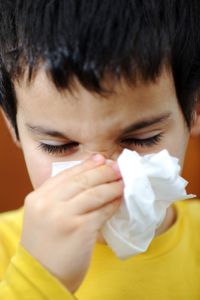Antibiotics and Kids: a Pediatrician’s Perspective
by Ritu Chandra, MD, FAAP
“My child has green snot…Therefore, my child needs antibiotics”
A t this time of year, it seems that everyone is at least sniffling. A lot of kids have nasal discharge, but the one symptom sure to have mommies calling into the pediatrician’s office is the first sight of “green snot.” This parental perception that green snot must mean the start of a “sinus infection” and automatically calls for antibiotics is fairly prevalent.
t this time of year, it seems that everyone is at least sniffling. A lot of kids have nasal discharge, but the one symptom sure to have mommies calling into the pediatrician’s office is the first sight of “green snot.” This parental perception that green snot must mean the start of a “sinus infection” and automatically calls for antibiotics is fairly prevalent.
While nasal discharge that is yellow, green or brown can be a sign of an infection of the upper respiratory tract, in the vast majority of instances the infection is caused by a common cold virus and will get better on its own within seven to ten days. After your child has blown his/her nose, the contents of the tissue may show that the mucus is clear, yellow, green, or have a reddish or brownish tinge to it.
What do those colors mean? You might have heard that yellow or green mucus is a clear sign that you have an infection, but despite that common misperception, the yellow or green hue isn’t due to bacteria!
Why Does The Mucus Change Color?
When you have a cold, your immune system sends white blood cells called neutrophils rushing to the area. These cells contain a greenish-colored enzyme, and in large numbers, they can turn the mucus the same color. Conclusion: even a viral cold can manifest with green-colored nasal mucus. So, the yellow or green color does not come from bacteria or guarantee that antibiotics will help get rid of the mucus.
As a parent, I assure you that I practice what I preach. My 3-year-old child has been in daycare since she was 2 months old. She has had more colds, complete with a runny nose and green-colored mucus than I can count. I do let each snotty nose run its course. Yes, every once in a while, when I see my child blow her nose and produce large quantities of snot, the mommy in me gets quite despondent for a cure. Then, I wait it out. The snotty nose goes away with no antibiotics. Sometimes, we quip that the cold takes seven days to run its course at home and one week if you visit the doctor!
What? No antibiotics?!
I want to share with you how overuse of antibiotics impacts our children today. For example, nowadays, the starting dose of Amoxicillin that is recommended for ear infections is nearly double of what it used to be. Due to the overuse of antibiotics, the bacteria became resistant to the lower dose of Amoxicillin. The higher dose causes more side effects. Yes, the diarrhea that we often see is due to the high dose of the antibiotics that are prescribed. Also, overuse and inappropriate use of antibiotics creates “superbugs” or very resistant bacteria. Antibiotic resistance is a serious and growing phenomenon in contemporary medicine and has emerged as one of the pre-eminent public health concerns of the 21st century.
It is important to acknowledge that a child with a serious ear infection or bacterial sinusitis may in fact have perfectly clear mucus AND be in need of antibiotics. And sometimes, the viral sinusitis can progressively become a bacterial sinusitis. The key is that we have to look at the big picture and not just the color of the mucus. The big picture includes consideration of the following criteria: duration of symptoms, any fever, any malaise, any associated coughing, headache or pressure over the face, the child’s activity level and the child’s appetite.
So, when is it really called bacterial sinusitis?
The clinical diagnosis of acute bacterial sinusitis is based solely on history. In order to make a diagnosis of acute bacterial sinusitis, there should be nasal discharge and a cough for 10-14 days without improvement or severe respiratory symptoms with pus-like nasal discharge and a fever of >102F for 3-4 days.
As a pediatrician, how do I deal with the demand and/or expectation for antibiotics?
For any pediatrician, it is easier to take 30 seconds to write a prescription for antibiotics rather than take the extra 5-10 minutes to explain to the family that antibiotics are not needed. Pediatricians most often do not take the path of least resistance. In fact, most often we do not write for unnecessary antibiotics because we want to do the right thing for the patient and for the community. Therefore, we take the extra time to try and educate the family, including the anxious parents, aunts and grandparents.
When I see a child with green nasal discharge and the parents/grandparents are requesting antibiotics, I try to address the expectation and/or anxiety of the family. Often times I agree to a “compromise.” I agree to write a safety-net prescription for antibiotics and give the family specific instructions about when the prescription must be filled.
For example, I tell them to please fill the prescription only if the child develops a fever or fussiness or if the nasal snot continues beyond another 48 hours. Sometimes, I actually post-date the prescription so that it cannot be filled immediately. By handing the family a safety net prescription, the family does not feel disappointed or that they “wasted their time” because they came to the doctor and left without a prescription or, that the pediatrician did not listen to them or, that if the child continues to be sick they will have to make a return appointment to see the pediatrician to get a prescription for an antibiotic. The ‘safety net prescription’ is a win-win strategy for all. I say that if you are in a similar situation, it would be reasonable for a parent/family to ask their pediatrician to consider giving them a safety net prescription for antibiotics.
So, what can you do to help make kids feel better? As I always say: water, water water.
Increase fluids that kids drink. Really push water. And unless a child is allergic to milk, it is an old wives’ tale that milk will make the mucus worse. If that’s what they want, they can have milk with a cold. What really needs to happen is to get the mucus out. Using saline along with a strong blowing (or suctioning) of the nose is important.
Other treatment tactics may include: warm steam inhalation or a humidifier to help clear mucus. Additionally, over-the-counter cold and cough medications can help to clear out congestion. Infants and younger children may struggle to blow forcefully enough to get the mucus out. I recommend nasal aspirators that seal outside the nose and have a continuous flow of air. Check out How to use the Nosefrida. A similar nasal cleaner is available from Nasopure. (Note: I am not tied to either of these companies and do not get any payment from either company.)
Dr. Ritu Chandra is the founder of Preferred Medical Group, with locations at Phenix City Children’s and Fort Mitchell Clinic. She is a board-certified pediatrician and specializes in ADHD, asthma, and school-related problems.
Photo Credit: GraphicLeftOvers.com


